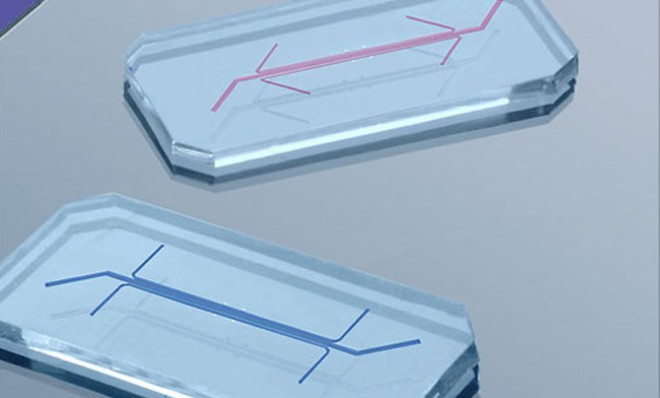Could the 'lung on a chip' help end animal testing?
Merck & Co may use an inspired microchip to help test its new asthma drugs

On the hunt for a new asthma medication, pharmaceutical giant Merck & Co is looking at a new technology for testing potential drugs — a tiny "lung" that lives on a microchip. This is fantastic news for mice who might otherwise have the drugs tested on them.
How do you build a model of a human lung on a few-inch-long chip? First, scientists bound together the important cells that make up a lung, then went about recreating the organ's functions. The mini-lung "consists of a see-through strip of silicone rubber about the size of a memory stick, with tiny, hollow channels through which air and fluid can pass," says the Wall Street Journal. "These channels are split by a flexible membrane, whose sides are lined by walls of human lung tissue and blood-vessel cells. Like in breathing, the walls of cells can relax and contract, thanks to the application of suction." Air flows along one side of the membrane, and fluid the other, mimicking air and blood in the human body. Researchers can then use the "lung" to test new medications.
The technology is not ready for widespread adoption — regulators have yet to allow it for use in deciding whether a drug will be tested on humans. That means lab mice are still a ways off from feeling the technology's potential benefits. But researchers are optimistic that this discovery could help to end animal testing.
The Week
Escape your echo chamber. Get the facts behind the news, plus analysis from multiple perspectives.

Sign up for The Week's Free Newsletters
From our morning news briefing to a weekly Good News Newsletter, get the best of The Week delivered directly to your inbox.
From our morning news briefing to a weekly Good News Newsletter, get the best of The Week delivered directly to your inbox.
"We believe that our human breathing Lung-on-a-Chip, and other organ chips we have in development, represent a first wave of exciting new alternative approaches to animal testing that hopefully will change how drug development is carried out in the future," Donald Ingber, the founding director of the Wyss Institute for Biologically Inspired Engineering, told the Harvard Gazette.
The technology may also help make up for limitations inherent in testing human drugs on other species. Here's the Wall Street Journal:
Animal disease doesn't faithfully replicate asthma, for instance. The condition is uniquely human, says Merck's Dr. Nicholson, and animal models can't capture the constriction of airways and all of the other characteristics of the disease.
"We have found great mechanisms that can control asthma in an animal," he says. "And most of them have failed" in humans. [Wall Street Journal]
The National Institutes of Health, the Food and Drug Administration, and the Defense Advanced Research Projects Agency are all funding further research at Wyss, where the lung on a chip will be combined with nine other organ chips into a whole "human body on a chip" that could allow scientists to test drugs' effects on the entire body's physiology.
A free daily email with the biggest news stories of the day – and the best features from TheWeek.com
Carmel Lobello is the business editor at TheWeek.com. Previously, she was an editor at DeathandTaxesMag.com.


